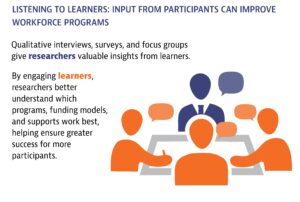Key Highlights
Challenges
Outcomes-based programs for workforce development have so far not relied heavily on input from prospective students, who are navigating a complex credential marketplace and financial aid options tied more to access and enrollment than completion and employment.
Many of these outcomes-based training programs, such as Pay It Forward Funds and Income Share Agreements, seek to train workers for well-paying, in-demand jobs and reduce financial barriers for workers, who often struggle to identify suitable training opportunities and afford them.
While these models are promising, much remains to be learned about how best to structure and implement such outcome-based approaches. So far, evaluations have solely relied on quantitative measures like job placement rates, leaving room for further insight.
Opportunities
By engaging directly with people with lived experience of today’s credentialing challenges, Worker Voices helped explain the motivations and experiences influencing labor market data trends. For example, workers noted that their personal journeys were not reflected in economic data, employer sentiment, or national narratives around the worker shortage during 2022.
Conversations about workers’ experiences offered a broader understanding of how workers define the quality characteristics of a job. This understanding helped employers better appreciate the perspectives of their incumbent or future workforce when adopting certain practices or developing policies.
Following the model of Worker Voices, the Federal Reserve Bank of Atlanta conducted one-on-one interviews with former students of an outcomes-based workforce development program. This type of qualitative research, such as intentional interviews, focus groups, or open-ended survey questions, can add to the accuracy and richness of program evaluations, enabling the operators of outcomes-based programs to enhance the design of their training programs and ultimately improve employment outcomes for a greater number of participants. Real-time feedback loops can allow for timely adjustments that increase program completion and post-training success.

Findings and Next Steps
- Interviews with learners offered the Atlanta Fed valuable insights into areas like communication, program structure, case management, counseling, and loan repayment.
- Though interviews are labor-intensive, focus groups and open-ended surveys can also provide meaningful feedback to support program design, improvement, and redesign. Gathering this kind of qualitative information, even from a small sampling of learners, can generate valuable feedback.
- Combining qualitative insights with traditional evaluation methods like administrative data and causal analysis can successfully help design new programs, modify ongoing programs, and redesign existing programs.



